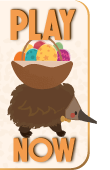Single vs Multi-needle Embroidery Machines
Author: Gary Walker Date Posted:1 April 2018
Many home embroiderers have purchased several embroidery machines over the years but still struggle with the basic physics of embroidering certain articles. Don’t worry, it’s probably not your fault. Hooped machine embroidery can be demanding and the tools you use can certainly make a difference.
Did you know that the basic principle of a home embroidery machine has changed little since the first fully automated machine was launched back in the late 1980s? They featured a single-needle design, a hooping system that by commercial standards was left wanting and a thread tension system that is not ideally suited to embroidery. Sadly, even the latest home embroidery machines selling at almost $10,000 have not all adopted the most basic commercial standards.
In this article I will explain the real differences between the latest multi-needle embroidery machines and their household cousins. You will then have a better understanding as to why sometimes certain designs simply don’t stitch as well as you would like.
We have focused primarily on the Brother PR series – our reference machines, and firmly believe these to be the outstanding class-leaders in embroidery technology today. You will be amazed at how simple the latest technology is to use and how this translates into better quality embroidery.
Advantages of multi-needle technology
Multiple needles
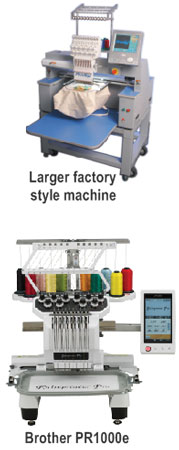
Multi-needle means the machine incorporates more than one needle in the sewing head. Typically, machines can vary from 4 to 16 needles and more needles will generally mean a larger, heavier machine. This is an important consideration and your choice of machine can be influenced by the size and location of your sewing or embroidery room.
If, for example, you have a dedicated embroidery room on a ground floor with easy access, a larger factory style machine may be suitable. They can be very heavy and often will not fit through a standard doorway. So prior research is important to ensure easy hassle free installation.
On the other hand, if portability and or space is a concern then the compact Brother PR655C with 6-needles or the PR1050 with 10-needles is a logical option. The weight is only about 40kg. Another advantage with a PR series is that you can take the machine to a service technician when due for service. This can save you money by avoiding technician callout or travelling time fees.
Multi-needle embroidery machines have been available for decades but it is the recent change in pricing, affordability and the new compact design of the PR series machines that has stirred all the interest. The obvious benefit of a multi-needle machine is that you will spend less time changing threads – in reality, the benefits go much further than convenience. So let’s take a look at just what they are.
Speed of embroidery
The stitching speed, usually termed 'stitches per minute' (SPM) is a definite advantage on multi-needle machines. Again the speed will vary depending on the configuration of the machine but you can expect a much faster stitching time on most multi-needle machines when compared to single-needle machines. When you combine this with the clear benefit of less thread changes, it’s obvious the time spent 'babysitting' your embroidery machine will be greatly diminished.
But machines don’t always stitch at full speed. Perhaps you have noticed that your existing machine sometimes slows down for certain areas of a design. Most notably, during the stitching of satin stitches, and the longer the satin stitch, the slower the machine speed.
This same principle applies to multi-needle machines but not at the extreme levels often found on home or single-needle machines. There are actually a number of other reasons for this 'slow down' which we will be explained in due course, but suffice to say, multi-needle machines are designed to cope with the greater speeds.
As a final note on machine speed, a 40,000 stitch design with 10 colour changes may take twice as long to embroider on some home embroidery machines and require constant attention to change colours when required. Basically, you have to keep a watchful eye on your machine for hours on end in order to complete larger designs. Multi-needle machines free up an incredible amount of your time.
Design of the hoop
The embroidery hoop is fundamentally the most important accessory for an embroidery machine. We all know the importance of hooping and stabilizing and the roll it plays in producing a quality embroidered article.
The difference in hoop design between a single and multi-needle machine is staggering. Sure they look alike and obviously serve a similar purpose but that is where it ends. Let’s take a closer look.
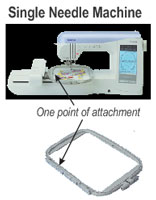
How does the hoop attach?
Home embroidery machine hoops have only one point of attachment to the machine. This provides less stability and can allow the hoop to slightly pivot or move during embroidery, which can sometimes result in design registration errors. This is more prevalent while embroidering heavier articles such as bathrobes and quality towels.
By contrast, the multi-needle hoop clips onto a 'U' shaped frame driver, attaching in two locations. This provides far superior hoop stability which in turn, results in more precise embroidery.
What about the strength of the hoop?
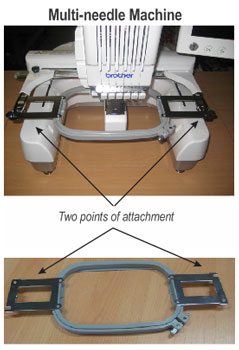
The multi-needle machine has a much more rigid hoop with less flex. You may have already experienced the common problem of heavier articles falling out of the hoop during embroidery, which of course makes for a disastrous result.
The more robust hoop of a multi-needle machine handles these heavier fabrics such as towels and robes with ease, and of course, is a great advantage when hooping multiple layers of stabilizer.
Obviously home or single-needle machines are limited simply because of the design of the machine. The drive mechanism that moves the hoop is not as robust and powerful as a multi-needle machine and is limited by the size and technical design of the home-style single-needle machine. Lightweight hoops help to limit the wear and tear on the machine but do nothing to improve the hooping ability, especially on heavier fabrics.
The Size of the Hoop
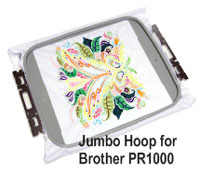 The size of the hoop or more correctly the sewing field is extremely variable from machine to machine. Typically, single-needle machines have a smaller sewing field but can have very large hoops. Unfortunately, the large hoops often require the design to be split, as the hoop itself must be rotated or moved to facilitate the large design.
The size of the hoop or more correctly the sewing field is extremely variable from machine to machine. Typically, single-needle machines have a smaller sewing field but can have very large hoops. Unfortunately, the large hoops often require the design to be split, as the hoop itself must be rotated or moved to facilitate the large design.
Generally a multi-needle machine will have a larger sewing field which will NOT require the hoop to be moved or rotated. The Brother PR650 features a full size 300 mm x 200 mm sewing field with the PR1000 featuring a 360 mm x 200 mm field size. A new Jumbo Hoop (360 mm x 360 mm) is available for the PR1000 and while it is a rotational hoop, the new InnovEye™ technology helps to ensure near perfect alignment of split designs.
What do they mean by tubular embroidery?
Tubular embroidery is brilliant and something that is very difficult to achieve on a home-style single-needle machine. Put simply, tubular means you can embroider tubular garments such as singlets, socks, sleeves, bags, hats, jeans – in fact, almost anything. Here’s how it works!
On a home-style machine you will have noticed that the part of the embroidery hoop that actually attaches to the machine is always on the underside of the fabric or article to be embroidered. Whereas on a multi-needle machine hoop, it is exactly the opposite. Combine this with the two points of attachment and you can easily embroider almost any tubular article by simply slipping the tube over the cylinder (or free arm) of the machine. There is almost never any need to undo side seams as you would with the leg of pants or a small sleeve. Plus, embroidering on articles like a sports bag is a breeze. In essence, this feature opens up a whole new world of embroidery opportunities.
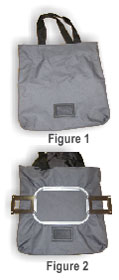 Examples of Tubular Embroidery: Tote Bag
Examples of Tubular Embroidery: Tote Bag
In this example we are using a nice quality tote bag shown in Figure 1. This bag is made from a reasonably heavy-gauge synthetic material and would be almost impossible to embroider on a conventional homestyle single-needle machine without unpicking seams. However, it is a very simple task for a multi-needle machine.
Simply place the outer hoop ring into the inner part of the bag with an appropriate stabilizer and press the inner hoop ring into position making sure not to catch any internal pockets or fixtures as shown in Figures 2 & 3.
Note how the attaching points for the hoop are on the outside of the hooped bag. This allows us to then attach the frame to the machine by slipping the tube of the bag over the cylinder or free arm of the machine as shown in Figures 4 & 5.

Examples of tubular embroidery: sleeve
Embroidering on sleeves and legs of pants or jeans is very popular and again a multi-needle machine makes it easy. In this example we have hooped a polo shirt sleeve with a 100 mm x 100 mm hoop.
Again, we simply attach the hoop to the machine ensuring that we slip the sleeve tube around the cylinder or free arm of the machine.

The benefits of tubular embroidery can never be overstated. It truly does expand your embroidery options enormously and improves the overall quality of your finished work.
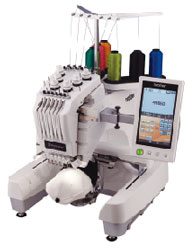 Additional frame systems: Cap frame
Additional frame systems: Cap frame
One of the most fancied features of a multi-needle machine is its ability to embroider caps and hats. However, the machine must be of a tubular style like the Brother PR650 which allows for cap designs to be up to 130 mm x 60 mm. Note: Cap frames are supplied as standard with the PR650 and are optional on the PR1000.
The PR1000, when fitted with the optional wide cap frame will provide an embroidery area of 360 mm x 60 mm, often referred to as 'Ear to Ear'.
Cap hoops require a specific style of framing system that actually rotates in a cylindrical fashion. This is simply not an option on a home-style single-needle machine.
Cylinder frame
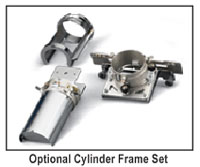
Round frame kit: option for PR655/1000
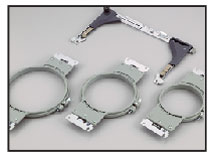
Round frames do provide more stability for the hooped item and are the first choice for the commercial embroiderer. The optional round frame kit for the PR1000 includes a 1 x 10 cm, 1 x 13 cm and 1 x 16 cm frame plus the embroidery frame holder.
Border frame: option for PR655/1000
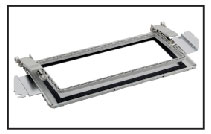
Designed for long objects such as table runners. The border frame is a clamping style frame that allows you to re-hoop your fabric without removing the frame from the machine. Just release the latches, slide the fabric to the next embroidery position and relock. The embroidery area is a 300 mm x 100 mm.
Hoop and frame summary
As you can now see, there is a mountainous difference between the hoops and framing techniques of conventional home-style embroidery machines and multi-needle machines.
For many, hooping is arguably the most frustrating aspect of machine embroidery and multi-needle machines go a long way to easing this frustration. The quality and efficiency of the tubular hooping system over the conventional home machine system cannot be questioned. With the price gap closing between the two styles of machines these benefits can be had by all.
Thread tension system
For most people the mere mention of the words 'thread tension' is enough to turn them off embroidery and that is perfectly understandable. Achieving a perfect stitch relies on a combination of many things and naturally the thread tension system is one of the most important components.
At first glance a multi-needle machine with its corresponding number of tension dials looks quite daunting, but it is in fact, quite the opposite.
There is a substantial difference between the technology used on home embroidery machines and most multi-needle machines. Before we explore this difference, it is important to understand that thread tension can affect so many aspects of embroidery.
Excessively tight thread tension can result in:
- Constant thread breakage
- Puckering of the fabric
- Poor design registration/pull (outlines that don’t line up)
- Bobbin thread showing on the top of the design
- Stitching that sinks or almost disappears into the pile of the fabric
- Needle breakage
By contrast, a tension that is too light will cause:
- Loose, loopy stitches
- Thread breakage and or shredding
- Missed stitches – often referred to as 'slip stitches'
- In extreme cases a birds nest of thread can form under the fabric, which can also cause needle breakage
There are basically two ways to apply tension to thread, the first and most common approach for home-style embroidery machines is what is called a compression tension. In other words, the thread will pass between two metal disks that are pressed together by an adjustable compression spring. This applies tension directly to the thread itself and is a system that dates back to the 1800s. Almost all sewing machines use this type of tension device, which is fine, as a reasonably tight tension is needed for traditional sewing.
Computerized embroidery however does not require the tight stitching of traditional sewing and for this reason almost all multi-needle machines incorporate a system often referred to as spinning or rotary tension. This system does not apply tension directly to the thread. The thread is in fact guided by a spinning wheel that has tension applied to it. This allows for a lighter but more consistent tension.
The result is more control and less tension related problems, with far less thread breakage even at the higher speeds that are achievable on a multi-needle machine.

So many advantages!
What we have covered so far is only the tip of the iceberg. Multi-needle machines are simply outstanding and when it comes to what I like to call the 'cross over or semi commercial' machines, Brother is in a class of its own.
Of course, if you were wanting a machine to embroider 12 hours a day, 7 days a week, there is an argument to say that a bigger, more heavy duty machine may be worth considering, but to be honest, after nearly 10 years on the market, the Brother PR series multi-needle machines have proven to be simply outstanding in all areas. For the perfect home embroidery machine, that can double as a small embroidery business machine and at a reasonable price, the Brother PR series is the ideal choice.
Now with the InnovEye™ camera technology built-in as standard on the PR1000e, multi-needle embroidery machines are even more compelling.
As many would know, my background is in the industrial sewing machine industry. I served my apprenticeship as a sewing machine technician with Stubbies Clothing Company, which once employed hundreds of sewing machinists in Brisbane alone.
I understand commercial sewing equipment and that is why I am so passionate about multi-needle embroidery machines – they are now so affordable and compact enough for any home embroiderer to take advantage of.
I also have had 32 years experience with Brother in commercial sewing machinery in one way or another and when it comes to the technology behind embroidery, Brother have truly set many benchmarks.
The ideal workspace
The Echidna embroidery cabinet has been designed jointly by Echidna Sewing Products and Horn Furniture to be the perfect workspace for compact commercial style machines. Its development along with other Echidna innovations like the PR Platform and our Echidna Thread Stand, signifies yet again our commitment to the home and small business embroidery market.
You can rest assured that our commitment is your guarantee of quality and ongoing support in the embroidery industry.
I hope this information has enlightened you about multi-needle machines and will help with your future embroidery plans.






